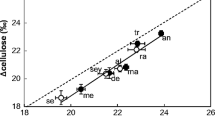Summary
Measurements of leaf thickness and δ13C value were obtained for twenty species and three intergeneric hybrids of the Crassulaceae. The data include plants growing in their native habitats and also in greenhouse cultivation. There is a strong relationship between leaf thickness and leaf δ13C values. The plants with the thickest leaves of ca. 7 to 11 mm had δ13C values ranging from -11.5‰ to -13.8‰. Plants with leaves that were thinner than 2.0 mm all had δ13C values that were more negative than -23‰. Plants having intermediate leaf thickness possessed intermediate δ13C values. The leaf tissue of four genotypes spanning the range of leaf thicknesses all exhibited a two-fold or greater nocturnal increase in titratable acidity. It appears that the differences in leaf thickness and δ13C values among the tested species are genetically determined.
Similar content being viewed by others
References
Clausen RT (1959) Sedum of the Trans-Mexican Volcanic Belt, Ithaca: Cornell University Press. pp 1–380
Clausen RT (1975) Sedum of North America north of the Mexican Plateau, Ithaca: Cornell University Press. pp 1–742
Crews CE, Williams SL, Vines HM, Black CC (1976) Changes in the metabolism and physiology of Crassulacean acid metabolism plants grown in controlled environments. In: CO2 Metabolism and Plant Productivity RH Burris and CC Black (eds), Baltimore: University Park Press. pp 235–250
Kluge M (1977) Is Sedum acre L. a CAM plant? Oecologia (Berl) 20:77–83
Kluge M, Ting IP (1978) Crassulacean acid metabolism: Analysis of an ecological adaptation, Berlin: Springer-Verlag pp 1–209
Knopf O, Kluge M (1979) Properties of phosphoenol pyruvate carboxylase in Sedum species in relation to Crassulacean acid metabolism (CAM). Plant Cell and Environment 2:73–78
Nishida KL (1977) CO2 fixation in leaves of a CAM plant without lower epidermis and the effect of CO2 on their deacidification. Plant and Cell Physiology 18:927–930
Rundel PW, Rundel JA, Ziegler H, Stichler W (1979) Carbon isotope ratios of central Mexican Crassulaceae in natural and greenhouse environments. Oecologia (Berl) 38:45–50
Teeri JA, Schoeller DA (1979) °13C values of an herbivore and the ratio of C3 to C4 plant carbon in its diet. Oecologia (Berl) 39:197–200
Troughton JH (1979) δ13C as an indicator of carboxylation reactions. In: M Gibbs and E Latzko (eds) Photosynthesis II. Photosynthetic Carbon Metabolism and Related Processes Berlin Heidelberg New York Springer-Verlag
Winter K, Lüttge V, Winter E, Troughton JH (1978) Seasonal shift from C3 photosynthesis to Crassulacean acid metabolism in Mesembryanthemum crystallinum growing in its natural environment. Oecologia (Berl) 34:225–237
Author information
Authors and Affiliations
Rights and permissions
About this article
Cite this article
Teeri, J.A., Tonsor, S.J. & Turner, M. Leaf thickness and carbon isotope composition in the Crassulaceae. Oecologia 50, 367–369 (1981). https://doi.org/10.1007/BF00344977
Received:
Issue Date:
DOI: https://doi.org/10.1007/BF00344977




